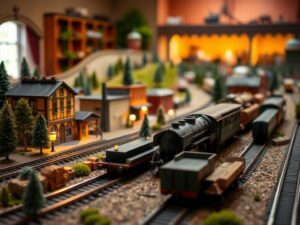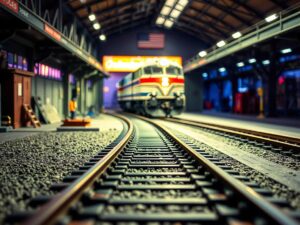How to Keep Your HO Scale Layout Running During Winter
How to Keep Your HO Scale Layout Running During Winter
How to Keep Your HO Scale Layout Running During Winter
As passionate model railroaders, our layouts are more than just static displays; they’re living worlds that chug, hiss, and flicker with life year-round. But winter brings its own unique set of challenges â freezing temperatures, snow drifts, and unpredictable humidity swings can all wreak havoc on our meticulously crafted landscapes and hard-working locomotives. Don’t fret, fellow enthusiasts! This detailed guide will walk you through everything you need to know about winter care for HO scale trains and ensure your layout stays running smoothly throughout the coldest months.
1. Understanding Winterâs Impact
Before diving into solutions, it’s crucial to grasp how winter conditions affect our beloved hobby. Here are a few key points:
- Temperature Fluctuations: Rapid changes in temperature can cause expansion and contraction of materials, potentially leading to stress fractures or track warping.
- Freezing Water: Moisture accumulation in locomotives, wiring, and ballast can freeze, expanding and causing damage. This is particularly dangerous inside sealed compartments like cab interiors and transformer housings.
- Condensation: Indoor heating can lead to condensation buildup on colder surfaces within your layout room, which can contribute to rust and corrosion.
2. Pre-Winter Layered Defense
Think of your winter prep like layering up for a snowstorm. The key is a multi-faceted approach to tackle each challenge:
- Temperature Control: Maintain a stable temperature in your layout room as consistently as possible. Ideally, aim for between 60°F and 75°F (15°C â 24°C). Investing in a programmable thermostat can help achieve this consistency.
- Ventilation is Key: Good ventilation is crucial to prevent moisture buildup. Consider installing an exhaust fan or leaving windows slightly cracked when the outside air temperature permits. This also helps prevent odors and excessive humidity from damaging materials.
3. Engine Overhauls and Storage
Winter maintenance goes beyond simply running your engines; it requires thorough inspections and potential repairs. Hereâs a breakdown:
- Lubricate, Lubricate, Lubricate: Check all moving parts of your locomotives, including gears, axles, and tender wheels, and lubricate them with a suitable oil or grease. Consider silicone-based products that are less prone to gumming up in cold weather.
- Tighten Everything Up: Securely fasten all screws, nuts, and bolts to prevent vibration loosening during operation.
- Electrical Checks: Examine wiring for any frays or breaks. Clean connectors with isopropyl alcohol and apply dielectric grease to ensure good contact. Remember, water and electricity donât mix!
4. Track Maintenance for Winter Survival
Your tracks are the lifeblood of your layout. They require extra care during winter:
- Clean Tracks: Dust, dirt, and grime can accumulate on your track and affect train performance, especially when combined with condensation. Use a brass pick to gently scrub both rails, removing debris and oxidation.
- Keep Them Straight!:
Snow and ice can cause warping in turnouts and straight sections. Regularly check for bends or misalignments and make adjustments as needed. - Consider Rail Heater Systems: If you’re experiencing particularly harsh winters, invest in rail heater systems designed to keep your tracks warm and free from frost.
5. Protecting Your Structures and Scenery
Donât forget the smaller details! Your buildings, trees, and terrain features also require some TLC during winter:
- Cover Up: If possible, store delicate structures indoors or protect them with a lightweight sheet during severe weather conditions.
- Snow Drifting: A bit of snowy buildup on your layout can look fantastic! But remember that excessive snow can damage electronics or obstruct visibility. Consider incorporating drainage solutions like sloping ground or using lighter materials for ballast to help manage melting snow.
6. Power Play â Your Winter-Proof Wiring Strategy
Proper electrical systems are crucial during winter, preventing issues and protecting your layout from power surges:
- Power Conditioning: Consider investing in a power conditioner to regulate voltage fluctuations that can occur during extreme weather. This will help protect your locomotives and other electronics.
- Check GFCIs: Ground Fault Circuit Interrupters (GFCIs) are essential safety devices, particularly when working with water features or exposed electrical components. Ensure they’re functioning properly and replace any faulty ones.
7. Keeping It Cozy â Winter Operating Habits
Small adjustments to your operating routine can go a long way during the winter:
- Donât Overload Circuits: Be mindful of the total current draw from your locomotives, especially if youâre running multiple trains simultaneously. Overloading circuits can lead to tripping breakers or even electrical fires.
- Minimize Water Features: While water features can add beauty to your layout, consider minimizing their use during winter. This reduces the risk of freezing and potential damage.
Final Thoughts – Your Community Awaits!
Remember, fellow model railroaders, weâre in this together! Winter doesn’t have to spell the end for your HO scale layout. By adopting a proactive approach, you can ensure it continues to operate smoothly throughout the colder months. Share your tips and tricks with our community â letâs learn from each other and keep those engines chugging!
Have a warm and rewarding winter season, building memories one tiny track at a time!




